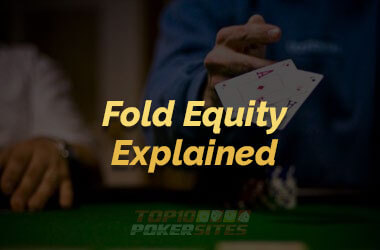What Is Fold Equity and Why Does It Matter?
Fold equity is a strategy often employed by players in No-Limit and Limit Hold’em. Read our guide to learn what it is and how to use it to your advantage.
 Like it or not, playing poker is all about making the most calculated move, even if it means folding. However, despite being in this situation, all is not lost.
Like it or not, playing poker is all about making the most calculated move, even if it means folding. However, despite being in this situation, all is not lost.
If you’ve been hitting the felt for some time, you’ve probably heard about the term “fold equity.”
This guide will give you a rundown of what it is and how it can be used in poker to help you improve your position. Read on.
What Is Fold Equity?
Fold equity refers to how likely it is that your opponent will fold if you bet or raise them. The equity changes based on your actions and the current size of the pot. For example, if there’s 25% equity that the player across you will fold at a $100 pot, then they have a 25% fold equity.
If you’ve ever tried to predict how likely a specific opponent is to fold based on your next move, you’ve dabbled in fold equity.
Players chasing the optimal poker strategy will refer to fold equity in every street. In case the cards don’t fall your way and you don’t get a high-ranking hand, calculating fold equity for your opponents can help you make the best possible decision regarding expected value.
Fold Equity Formula
Your opponent’s equity in the hand is just the percentage of the pot that they believe they will win on average on the river. To be more precise, it is the percentage equity of their range.
Fold equity is often used to calculate your total equity (TE): TE = fold equity + hand equity.
Fold Equity at Work
All these formulas could leave you with a lot of head-scratching, but things will become much clearer once we analyze how fold equity works in practice.
Let’s assume that our opponent has Q♦ and 10♣, and the flop shows J♠, Q♥, and 2♠. Our hand is 8♠ and 9♠. Based on our calculation, our win equity is 42.4%, whereas the opponent has an equity of 57.58%, meaning their chances of winning are better in this case.
Let’s say that our stack is short, so we don’t have much room — we must shove. From our previous experiences with the opponent, we have a 50% chance of scaring them into folding, thus securing the pot for the following round.
In this case, we have to deploy the fold equity calculation:
- FE = likelihood of opponent folding * opponent’s equity in the hand
- FE = (0.5%) * (57.58%)
- FE = 28.79%
Now it’s time to calculate our total equity in the hand:
- TE = fold equity + hand equity
- TE = 42.4% + 28.79%
- TE = 71.19%
Every time there’s a drawing hand and we decide to go all in, we have an average equity of 71%. Therefore, in the long run, shoving is a profitable move against a particular opponent.
It’s safe to say that we can make semi-bluffs more successful by calculating fold equity and, consequently, total equity.
Fold Equity in Poker Tournaments
Imagine playing in an online sit-and-go, with the chip leader left with around 40 BBs and the average stack size being half that. This is the part of the tournament where you need to either shove or fold.
Calculating fold equity could help you grab those chips and breathe more easily.
Best Poker Rooms To Play Online Tournaments
My list of the best poker sites which I consider to be the best rooms to play in 2024:- 100% Legal & Licensed
- Verified Bonus
- Mobile Friendly
- Advertiser Disclosure
Kindly be aware that some links on Top 10 Poker Sites are affiliate links, for which we may earn a commission. Find out more on our terms & conditions
- Must be 18+ to participate.
Displayed 3 of 8 rooms
Conclusion
To sum up, fold equity is something you’ve probably already considered without even realizing it. Making assumptions about your opponent’s moves is natural, but it’s always better to have your predictions converted into actual numbers.We did the grunt work to help you understand the math behind fold equity, which could improve your game on a per-hand basis and assist you in making a profit long-term.
Make sure to think about fold equity the next time you play poker, especially if you participate in a poker tournament and find yourself in an unfavorable position (short-stacked, with late blind levels).
FAQs
What is fold equity?
A fold equity refers to the probability that your opponent will fold if you raise them or bet.
How is fold equity calculated?
There’s a pretty simple formula that will help you calculate fold equity — fold equity = likelihood of opponent folding * opponent’s equity in the hand.
Can fold equity help me improve my poker skills?
Yes, it’s possible to improve your overall performance if you use fold equity correctly.



